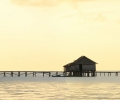Window Island Cottages
“Let’s go back to Window island,” I asked Asrin, my local friend and host, to drive his motor canoe to the tiny island across. I had explored the area around Tangkian, Asrin’s village, for the whole day to find a suitable beach or island for our project: cottages for tourists. There were seven white sand beaches but all of them had been bought by rich businessmen or local government officials. He and I had not enough money to buy from them. Dead end.
We had stopped at Window Island two hours before, but I did go ashore because it did not look a suitable place for cottages, too small (6 x 50 meter), no white sand, and poor coral reefs. Its uniqueness is the hole (two persons-width) in the center of the rock connecting its north and south coasts (see the photo). We landed on the south coast of the Island and walked about five meters to reach the “window.” There is only a narrow rocky platform (2 x 1 meter) behind the window. I could see the shadow of Una-una Island in the northwest horizon; the rest is an open ocean. I know the sunset moves across the Island in the year cycle and is always a wonderful panorama for daydreamers.
I looked south. And, the koan struck me. Separated by a narrow strait, about 100 meters, the Sun rises behind the forested hills of Kadidiri Island; its ray slowly changes the nuance of the mangrove leaves on the coast from dark to bright green and reveals the color of coral reef under the crystal water. A perfect view, but . . . no land to build the cottages.
“Do you think we can build stilt house here?” I asked Asrin.
He looked at the shallow bottom of the ocean. “We can, Doctor,” he answered.
“Five?”
“Maybe more if they are not big.” Then, the hardest problem was solved. The Window Island is a good place for ecotourism because it has a beautiful view around and colorful coral reefs, is near to the local village, and not far from two diving operators.
Later in the evening, I discussed our project plan with Asrin and the Head of the village. We were going to start by three persons before involving the whole community. The locals will provide the material and labor; the Foundation will cover the cost of furniture, electrical, water and sanitation systems, and operational expenses. The Foundation will spend about $750 per hut at the construction stage. The net profit will be divided between the owner (40%), the Foundation (40%), and health service for community (20%). The Foundation staff and volunteers will initially manage the cottages and transfer it gradually to the locals through internship method.
Both the village Head and Asrin were excited with our plan. They hope they can make more money with easier work; I hope I can save the terrestrial and marine wildlife of Togean Islands, my final project goal–the Head is an illegal logger, Asrin is a reef blaster and poisoner. What I need now is to find funding resources for the operational cost beyond the first six months and program expansion to the whole community.





